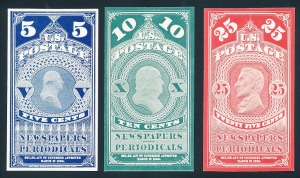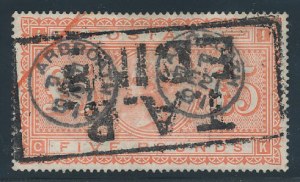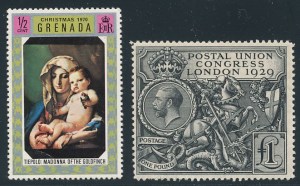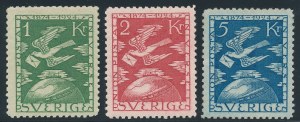Special Service stamps tell you a lot about a country. How does a country view charity? If the feeling is that the government should encourage charitable contributions to specific causes then that country will issue a lot of Semipostal stamps. Larger countries with lots of distance between cities issued a lot of airmails and special deliveries. And the United States issued over 120 Newspaper Stamps, winning the race in this category by a factor of ten over runner up Austria. Most countries never issued Newspaper stamps. None of the British Commonwealth nations did, nor did the German or French Area. The reason for the vast number of US Newspaper stamps is due to both the geographical distances between areas in the United States and a commitment since Revolution days to political discourse. Freedom of the Press is the first of the freedoms in the Bill of Rights and throughout the nineteenth century congress felt that this meant not only freedom to publish but also ease of dissemination.
Monthly Archives: February 2020
- Posted February 29, 2020in NewsRead more »
- Posted February 20, 2020in NewsRead more »
The first of the famous three stamp triptych of the 1920s-the Pilgrim set of 1920-has its centenary this year. These three sets- the Pilgrim set, the Huguenot-Walloon set and the Lexington-Concord set- defined the commemorative issues of the 1920's and as with most commemoratives displayed the self image that America wished to project at that time. The 1910-1924 period was a time of record immigration to America. But this immigration was politically contentious (just as today's is) and resulted in severe limitations of non-Western European immigration after 1924. It is odd that with the demographics of the United States changing by the immigration of millions of Eastern and Southern Europeans that the 1920 Pilgrim set would commemorate the few hundreds of early English descent. Political history and cultural anthropology as shown by postal issues is a new field and this early Pilgrim set in the midst of America's first great immigration fight is certainly interesting. As philatelists though,
- Posted February 16, 2020in NewsRead more »
Prices and the value of money are difficult to evaluate over time. Readers of Victorian novels know that in the late Nineteenth Century an income of about 150 Pounds a year was the minimum needed to live as a gentleman (Trollope says tartly "an embarrassed gentleman, yes, but a gentleman"). That was three Pounds a week and for that a person could rent an apartment, eat and have a part time servant. Before 1900, prices for food and clothing were proportionately much more expensive and labor was proportionately far cheaper. Sir Walter Scott writes that in his time one could engage a servant for little more than food clothing and shelter. Still, if a middle class person could live a decent life at three Pounds a week in Victorian England and the Post Office issued a stamp for five Pounds it would be the equivalent in spending power to a $1000 stamp today. This raises the question of what could such stamps possibly be used for. Mainly they was used by banks that sent quantities of cash and
- Posted February 09, 2020in NewsRead more »
Perhaps the greatest change in our hobby in the last 80 years has been in the quality of the product that we collect. Stamps have gone from miniature pieces of art that reflect the skill and technological prowess of the nation that issued them to being little more than a chit indicating payment of postage, usually with a theme to appeal to collectors. The change is not only cultural-taste and artistic standards are lower now than they used to be- but also reflect the diminished roll that letters, and consequently postage stamps, play in our society. Until about 1950 telecommunication was difficult and expensive and was only used for the most important communications. Costs of telephone use has lowered dramatically so that today the largest cost to the telecom companies is not the lines or the satellites but the actual costs of billing customers. Today, most people pay a flat monthly fee for all their telecommunications with no distinction between local and long distance. Email is essentially
- Posted February 06, 2020in NewsRead more »
By 1874 the system of international carriage of letters was a mess. Countries had to negotiate postal treaties with each other and most treaties called for cross payments where part of the postage of a letter was remitted by the sending post office to the receiving post office. This was confusing and difficult to keep tabs of but of further complexity was the cross payments to transit countries (say when a letter from the United States landed in England, was sent to Poland and then across land to Russia). Nearly thirty five years after the Penny Black, with world commerce rising, the system of cross payments just wasn't working. It was slowing down communication and as postage rates dropped it was becoming more expensive to account for the letters than to carry them. In 1874 the United States proposed an international congress to discuss the problem and what emerged was an agreement for an organization that was one of the first international cooperation organizations (it was in fact the
- Read more »
Chile was one of the last South American countries to be colonized. With little gold or silver to exploit or passive Indians to enslave, the southwest coast of South America was not as attractive to the Spanish invaders as was the rest of the new world. Colonization came later when copper was found, and when the rich Mediterranean style climate showed that European type crops (and especially grapes) could be grown and when steam sailing ships and railroads could link the long narrow nation. Geographically, Chile is a narrow ribbon of a nation averaging 100 miles wide by 2700 mile long. The first stamps of Chile were issued in 1853 and were produced in London. The plates were transferred to Chile and over the next fifteen years numerous printings were made. With "a" numbers, Scott recognizes about sixty different printing, shade, watermark and color varieties putting the first issues of Chile in the same class as the classic Hermes Heads of Greece as among the most super specialized stamps






